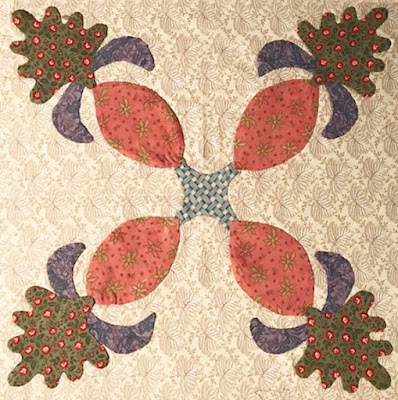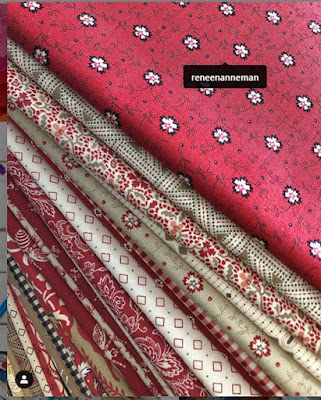Block #5 Pineapple by Becky Brown
remembers the Washington hospitals where poet
Walt Whitman was a volunteer.
American writer Walt Whitman was in his early forties when
the Civil War began. He came to Washington, the city of hospitals, looking for
his wounded brother in a false alarm.
Walt Whitman (1819-1892)
Portrait by the Brady studios in Washington City, 1860s
Moved by the suffering he saw he stayed in the Union capitol,
finding a government job that gave him time to visit hospital wards, volunteering to
help with nursing and provisions and to write about the horrors and humanity he
found.
Armory Square Hospital, which Whitman visited often, was located
where today's Smithsonian Air and Space Museum is
at Independence Ave and 6th Street. The stone building is the National Armory.
"There are not merely two or three or a dozen [Washington hospitals], but some fifty of them, of different degrees of capacity. Some have a thousand and more patients.
Ward at Armory Square
The wards are in the wood barracks-like buildings built especially as hospitals.
"The newspapers here find it necessary to print every day a directory of the hospitals; a long list, something like what a directory of the churches would be in New-York, Philadelphia or Boston... Whitman article for the New York Times.
"Each ward has a Ward-master, and generally a nurse for every ten or twelve men.... Some of the wards have a woman nurse -- the Armory-square wards have some very good ones. The one in Ward E is one of the best."
Carver Hospital was on Florida Avenue between 13th & 14th Streets NW.
Five purpose-built hospitals were erected in the city.
At Carver Hospital he brought ten gallons of
ice cream on a hot summer day in 1864, reporting to his mother:
"Many of the men had to be fed, several of them I saw cannot probably live, yet they quite enjoyed it, I gave everybody some--quite a number western country boys had never tasted ice cream before."
Ward at Carver Hospital.
The women in the wards may be family members personally
nursing their own soldiers or that rare female nurse that Whitman mentioned.
Sarah Low of Dover, New Hampshire worked in Washington,
first at the Union Hotel and then at Armory Square.
More about her in next Saturday's post.
In an 1863 letter Whitman wrote:
"I always carry a stout double-pocket haversack, filled with things—also large pockets in my coat &c—I have articles of many kinds.
The Smithsonian has Whitman's haversack in its collection.
"I have learnt what is appropriate—I generally carry a bottle of wine—I buy oranges by the box, & fill my pockets with them before going into a ward, they are very refreshing to feverish men this weather—I have nice preserved peaches or something of the jelly sort—to many I give little sums of money—the soldiers very largely come up here without one cent."
Block #5 Pineapple by Janet Perkins
With wine and fruit Whitman must have been a welcome visitor.
To his mother:
"I go every day without fail, & often at night—sometimes stay very late—no one interferes with me, guards, doctors, nurses, nor any one—I am let to take my own course."
The Block
The Pineapple was among the most popular mid-19th century patterns for repeat block quilts and samplers.
The center embroidery: "M.A.J. Connell A Present From Her Mother"
Georgia quilt project, photograph from their book Georgia Quilts
Barbara pieced her backgrounds of squares cut 9-1/2".
To Print:
Create a word file or a new empty JPG file.
Click on the image above.
Right click on it and save it to your file.
Print that file. Be sure the square is about 1" in
size.
Cutting:
For the background cut a square 18-1/2".
Add seam allowances to the pattern pieces if you are
doing traditional applique.
Block #5 Pineapple by Bettina Havig
Addition
Pineapple with dots by Becky Brown
Reverse applique dots!!!
Not going to happen.
From the Connell quilt.
Subtraction
Cut a square 9 to 10".
1 Each of A, B & C
Layer piece C over the others to fit
Denniele Bohannon's #5 Pineapple Sprout
Finished 9" Square
Add dots
After the War
Hospitals with long-term patients published newspapers to entertain patients and editorial staff.
Someone doodled leaves on an issue of the Armory Square Hospital Gazette. See issues at

The Air & Space Museum on the right today where Armory Square once was.
The barracks were probably demolished in the 1860s;
the original Armory building was torn down in 1964.
Armory Square hospital closed in September, 1865. Walt Whitman remained in Washington after the war, continuing in his job as a government clerk. While tending to his dying mother in Camden, New Jersey in 1873 he had a stroke, which made it impossible to return to his job. He stayed with his brother in Camden until royalties from his poetry books enabled him to buy his own house. Despite illness he continued to write and lecture until he died in 1892 in Camden.
Sampler album from the Steele family, documented in the
West Virginia project. From the Quilt Index.
Note border corners---one way to make it work without overlapping
the seams.
Block #5 Pineapple by Mark Lauer
Extra Reading:
See a short history of pineapples here:
https://encyclopediaquiltpatterns.blogspot.com/2019/06/hospital-sketches-block-5-pineapple.html
https://encyclopediaquiltpatterns.blogspot.com/2019/06/hospital-sketches-block-5-pineapple.html
Read about Civil War Washington at this website:
http://civilwardc.org/
https://barbarabrackman.blogspot.com/2015/06/baltimore-album-quilts-4x5s-and.html
Block #5 Pineapple by Paula Smith






















































